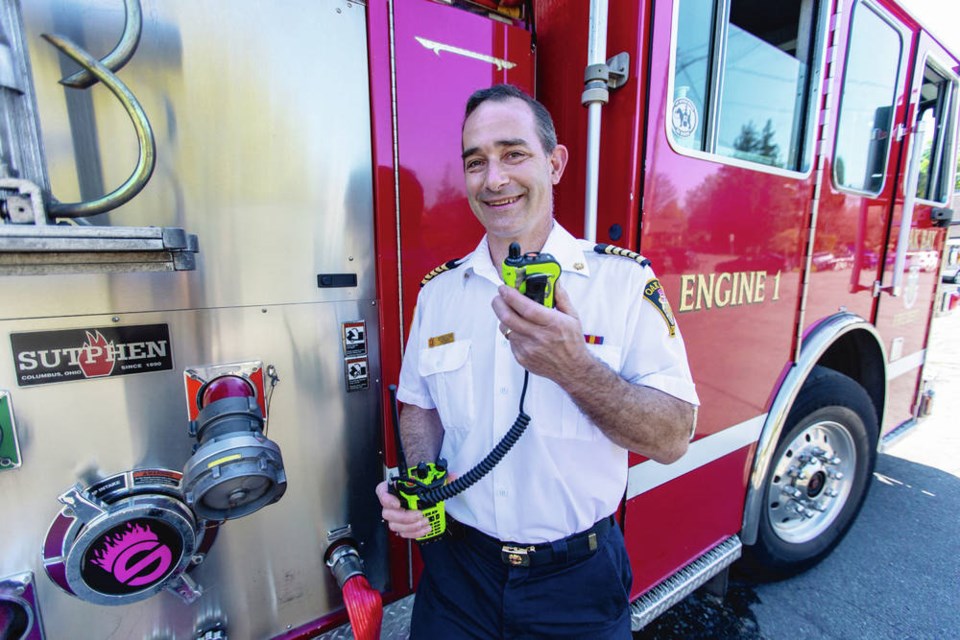Silence surrounding the region’s newly upgraded emergency communications system speaks volumes about its effectiveness, say those who use it every day.
Police and fire chiefs around the region say the lack of feedback from frontline staff on the new and improved CREST (Capital Region Emergency Service Telecommunications) system means it’s working as hoped to improve safety of emergency responders and the public.
“In fire service, no news is good news,” said Frank Macdonald, Saanich’s deputy fire chief. “When things are going really well, you tend not to hear people talking about it, but when things aren’t going well, you hear a lot, and we used to hear a lot of complaints about the quality of communication, or the lack of it.
“Right now, we rarely hear any chatter.”
Scott Green agrees. Saanich’s chief constable said whenever there’s an issue, it echoes through the lunchroom, gym and patrol room.
“But right now, it’s radio silence because the system is working,” he said. “Officers feel much safer and the coverage and reliability is much better in the new system.”
The improved CREST system has been fully operational since late fall after a four-year, $24.5-million upgrade that moved the system onto a fully digital platform that meets world standards for public safety.
The phased-in upgrade included new transmission towers, refurbishing older ones and programming and deploying 3,000 new radios for the 50 emergency-response agencies in the region.
Police, fire and ambulance workers had for years complained about communication dead zones, distorted messages and other failures, but that seems to be a thing of the past.
“They have seen a big difference,” said Gord Horth, general manager of CREST. “The new tech makes communication seamless as you pass from cell to cell.”
Horth said the new system, which has an expected lifespan of more than 15 years, now uses 30 towers spread around the region instead of 10, which drastically reduces radio-signal failures.
Macdonald, who was around when CREST was established 20 years ago and has heard the complaints over the years, said the system is now significantly more robust and powerful.
“It covers the same footprint with three times the number of towers,” he said.
Migrating to a digital P25 radio system from an analogue-digital VHF system has meant communication is clearer, and the new radios reduce background noise and environmental interference to improve communications within buildings and when conditions are less than ideal.
“The noise-cancelling technology and other features have reduced repeated communications and sped up message receipt and delivery,” said Darren Hughes, chief of the Oak Bay Fire Department, noting firefighters are more effective and everyone is safer when they can concentrate on their task rather than having to constantly repeat themselves when reporting their situation or the status of a fire.
“This is equipment that has to be reliable all of the time,” he said. “This is time-critical communication that has to work every time.”
Macdonald said on the old system, when firefighters were on the end of a hose or working with air packs, trying to communicate was difficult, leading to distorted and unintelligible messages being relayed.
“The amount of that has been greatly reduced, so it’s safer and more consistent,” he said.
Green said the difference is “night and day.” “The system has been good and reliable and much safer in my mind.”
He said being able to encrypt communications also offers privacy protection for members of the public interacting with police, and ensures operations are not compromised by people listening in.
CREST agencies place as many as eight million calls on the system each year, and has capacity for more.
Horth said the system has plenty of room to grow with the region. “Our system is capable of supporting 100 [communication towers] — it’s totally scalable,” he said.
While there are still gaps in the region — parts of the Gulf Islands and between Otter Point, Shirley and Port Renfrew, for example —CREST is working with Roger’s Communications on the possibility of piggybacking on new towers the company has planned for those areas, Horth said.
“There have been a lot of challenges in the past, but this could be a win-win.”



